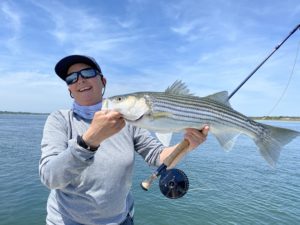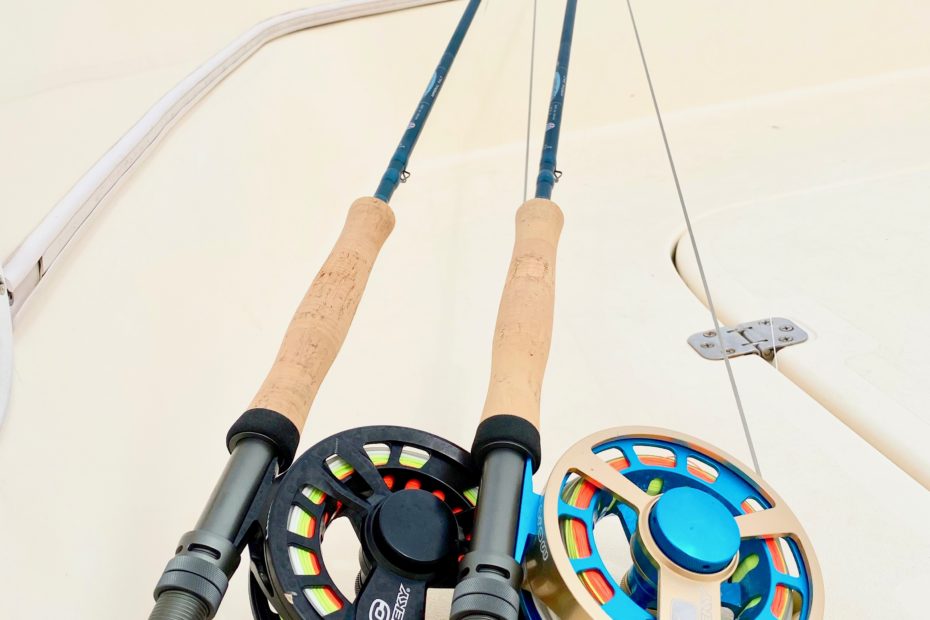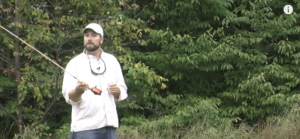As a Cape Cod Saltwater Fly Fishing Guide for more than twenty years, I have guided hundreds of striped bass anglers aboard my 20’ center console boat. In those years my clients have been experts, novices, and everyone in between. From most, I have learned, and some have even taught me a thing or two about fly fishing…:)
Now it’s my turn. I want to simplify or “demystifly-fishing”.
visit your local fly shop
Fly fishing can be very complicated AND EXPENSIVE! Or not! Sure, it costs something to buy a rod and reel, but I recommend that you take it slow. Find an affordable 8 or 9 weight fly rod & reel combination and spend your money on a good fly line. (Read on to learn more…) Ask your local fly shop to “line your reel” and tie on a leader. Finally, purchase four or five flies to get yourself started. Your local shop should be able to sell you a couple of (easy-to-cast) patterns that work well for your target species.
saltwater fly fishing
HOw far do I need to cast?
One of the most common questions I get from new clients is “How far do I have to be able cast to catch a fish?”.
My answer is simply, as far as you can consistently cast and manage your fly line. I have told clients many times, I would rather see them make a 40’-45’ cast over & over again without entangling themselves in the fly line, than nail a 70’-80’ cast once every three or four attempts and entanglements. After all, you can’t catch a fish unless your fly is in the water. It’s really that simple, and no, you don’t need to know how to “double haul” to catch a striped bass.
Distance casting and accuracy comes with good technique. Good technique comes with practice. You will be amazed at how much your casting will improve simply through time and repetition.
we all learn differently
I learn by watching and imitation. I teach through demonstration. For others, detailed technical instructions are the preferred avenue for understanding how best to cast a fly rod. Whatever your preference, the internet offers endless information and instruction. Even the most experienced fly caster can find helpful information through an internet search.
The Basics
No matter what your learning style, the mechanics of casting a fly rod boil down to a few simple concepts.
CASTING A FLY ROD:
1. FLY LINE IS WEIGHTED
2. CASTING A FLY ROD IS THE ACT OF “LOADING” THE FLY ROD WITH THE WEIGHTED FLY LINE
3. THE BACK-AND-FORTH ACTION OF A FLY CAST CREATES “LINE SPEED”
4. LINE SPEED “LOADS” THE FLY ROD
5. “LOADING” THE ROD CAUSES THE ROD TO BEND, OR ACT LIKE A BOW
6. THE ROD’S BOW IS WHAT PROPELS THE FLY LINE WITH THE FLY ACROSS THE WATER
casting a spinning rod
First, think about casting a spinning rod. When you cast a spinning rod, the weight of the lure “loads” the rod causing it to bow (or bend), and it is this bow that propels the lure out over the water. Casting a spinning rod is really creating a simple bow action, and anyone can learn to cast a spinning rod in just a few minutes.
casting a fly rod
It’s more complicated to cast a fly rod, nevertheless, it’s based on the exact same concept. The big difference is that the rod is “bowed” by the weight of the fly line, not by the fly. The back-and-forth motion of fly casting is the act of creating “line speed” to “load” and bow the rod.
When you cast a fly rod, YOU ARE CASTING THE WEIGHT OF THE FLY LINE.
It's all about the fly line!!!!!!!
The image above diagrams a typical 100’ saltwater fly line. Note that the 30’ “head” of the fly line is thicker than the remaining 70’ of “running line”. It is the “head” of the fly line that is weighted. When “loading” a fly rod, you are working with the “head” or the first 30’ of the fly line. The “running line” shoots out following the head when you make your cast.
Fly lines come in various configurations starting with “weights” to match your fly rod. Floating lines, intermediate lines, sinking lines, and are just some of the choices available for various fishing situations. For inshore striped bass fishing, I like to keep it simple with a versatile and easy to cast intermediate line. Ask your local shop to recommend a good line. Yes, it will cost you $100, but fly casting is ALL ABOUT THE FLY LINE!
The Technique
Almost everybody has seen it… The River Runs Through It… starring Brad Pitt (if you haven’t, you probably should). Everyone remembers the beauty of the river, the arc of the fly lines, and the forward and back casts of the anglers, an action that appears to be a buggy whip.
Do you know what is really going on? Fly casting…
IMPORTANT BASIC FLY-CASTING TERMS:
Forward Cast
Back Cast
Accelerate
Stop
Load the Rod
Tight Loops
Shoot the Line
Water Haul
forward and back casts
an important pause
the straight path
weight of the fly line
practice makes perfect
MOST IMPORTANTLY, take some time to practice your fly casting in your yard, or at a local school grounds, or park. If you get frustrated (and you will), take a break, and come back another day. Of course, finding a good teacher can’t hurt!
Check back regularly for more saltwater fly fishing tips
And if you live on Cape Cod or in Southeastern Massachusetts, call me for a fly casting lesson, or better yet… let’s go fishing!!!!



